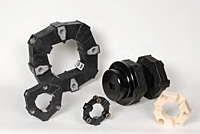- Product Types of LovejoyProduct Types of Lovejoy
- Couplings & Power Transmission Parts CatalogCouplings & Power Transmission Parts Catalog
- Torsional CouplingsTorsional Couplings
- LF SeriesLF Series
- LF Series Cylindrical Hubs - Rough Stock BoreLF Series Cylindrical Hubs - Rough Stock Bore
- Item Number 68514424516
Item Number 68514424516, LF Series Cylindrical Hubs - Rough Stock Bore
68514424516LF Series Cylindrical Hubs - Rough Stock BoreLovejoy
- The LF Series coupling is designed with a unique and highly versatile elastomeric element. These can be easily integrated into a variety of coupling configurations to meet several application needs. LF Style elements are available in a variety of materials to match the necessary coupling dampening characteristics for tuning the systems critical speed away from the application operating speed.
The element can be connected axially to a flywheel adapter plate or flanged hub and radially to a cylindrical center hub using the appropriate bolts. Axial bolt styles include either socket head bolts with a special dry adhesive, or S-Style bolts, which are similar to dowel pins (seen picture below). The radial bolts are used to connect the element to the cylindrical hub. This unique design is remarkably simple, highly effective and gives the LF torsional coupling unmatched performance capabilities. The coupling selection should be verified with a Torsional Vibration Analysis (TVA) of the system.
Unit of Measure
Notes
|
Specifications
|
Dimensional Data
|
Performance Data
|
Torsional Element Specifications
|
Features
Notes
Disclaimer |
N/A Lovejoy: CAD Models are accurate envelope dimensions only. Features such as bore size and keyway are not rendered or are only representative. Contact Lovejoy Technical Support or refer to product catalogs for details. |
Notes |
N/A
|
Specifications
Description |
N/A LF250-HUB CYL-1.57 RSB |
Coupling Size |
N/A LF250 |
Hub Style |
N/A Cylindrical |
Coupling Type |
N/A Torsional |
Color |
N/A Metallic |
Bore Type |
N/A Rough Stock Bore |
Weight |
N/A 37.00 lb |
Dimensional Data
Rough Stock Bore Size |
N/A 1.570 in |
Thread (Dimension T) |
N/A M20 |
Length thru Bore |
N/A 3.940 in100.00 mm |
Dimension HD |
N/A 6.300 in160.00 mm |
Min. Bore (Dimensions ID1/ID2) |
N/A 1.630 in40.00 mm |
Max. Bore (Dimensions ID1/ID2) |
N/A 4.250 in105.00 mm |
Cubic inches |
N/A 156.37860 in³ |
Performance Data
Normal Temperature Range |
N/A -40 to 194 ºF |
Nominal Torque |
N/A 26500.00 in·lb |
Max. Torque |
N/A 77400.00 in·lb |
Allowable Continuous Vibratory Torque |
N/A 11000.00 in·lb |
Max. Speed |
N/A 3000 rpm |
Max. Angular Misalignment |
N/A 2.00 º |
Max. Parallel Misalignment |
N/A 0.080 in2.00 mm |
Wind-Up Angle at Nominal Torque |
N/A 3.00 º |
Wind-Up Angle at Max. Torque |
N/A 7.50 º |
Dynamic Torsional Stiffness |
N/A 592900.00 in·lb/rad |
Static Angular Stiffness |
N/A 600.00 in·lb/deg |
Static Axial Stiffness |
N/A 6570.00 lb/in |
Static Radial Stiffness |
N/A 23400.00 lb/in |
Shore Hardness |
N/A 60A |
Torsional Element Specifications
Torsional Element Specifications |
N/A
|
Features
Features |
N/A
|


